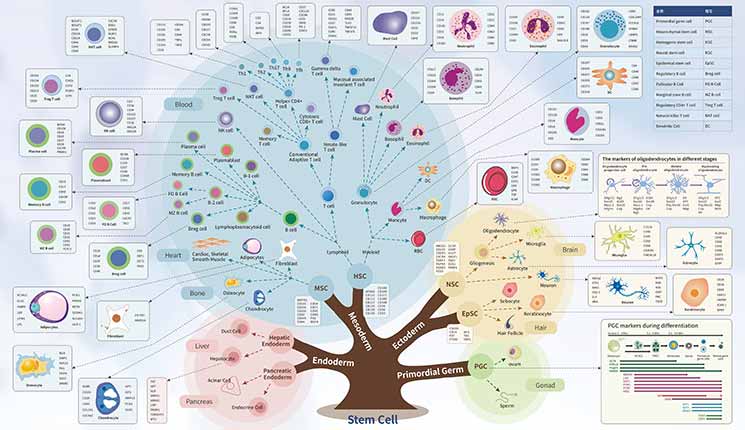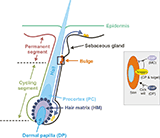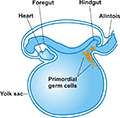Cell Markers
All cells express characteristic markers that can be used to distinguish them from other cell types, such as proteins, lipids and glycosylation. Cell markers can be expressed extracellularly on the cells surface or inside the cell as an intracellular molecule. This page covers surface and intracellular cell markers for a variety of cell types including immune cells, stem cells, central nervous system cells, and more.

Figure 1. The summary diagram of cell marker
(Click the image to enlarge it)
Cell Markers for Stem Cell
Hematopoietic Stem Cell (HSC) Markers

Figure 2. The diagram of HSC
Hematopoietic stem cells (HSC) are the stem cells that give rise to all blood cell types including myeloid(monocytes, macrophages, neutrophils, basophils, eosinophils, erythrocytes, dendritic cells, and megakaryocytes or platelets) and lymphoid lineages (T cells, B cells, and natural killer cells).This process is called haematopoiesis. This process occurs in the red bone marrow, in the core of most bones. In embryonic development, the red bone marrow is derived from the layer of the embryo called the mesoderm.
Mesenchymal Stem Cell (MSC) Markers

Figure 3. The diagram of MSC
Mesenchymal stem cells (MSCs) are multipotent adult stem cells that have self-renewal capacity and differentiation potential into several mesenchymal lineages including osteoblasts (bone cells), chondrocytes (cartilage cells), myocytes (muscle cells) and adipocytes. MSCs, the “other” bone marrow stem cells, mainly derive from bone marrow, and still is the most frequently utilized. Moreover, the source of MSCs also includes cord cells, adipose tissue, molar cells and amniotic fluid.
Neural Stem Cell (NSC) Markers

Figure 4. The diagram of NSC
Neural stem cell (NSC) are self-renewing, multipotent cells that firstly generate the radial glial progenitor cells that generate the neurons and glia of the nervous system of all animals during embryonic development. Some neural progenitor stem cells persist in highly restricted regions in the adult vertebrate brain and continue to produce neurons throughout life.
Epidermal Stem Cell (EpSC) Markers

Figure 5. The diagram of EpSC
Epidermal stem cells (EpSCs) are multipotent cell type and are committed to the formation and differentiation of the functional epidermis. It has a strong ability to divide and proliferate to supplement senescent keratinocytes.It is mainly located in the basal layer of the epidermis and belongs to adult stem cells. Hair follicle stem cells ensure constant renewal of the hair follicles. As the contributions of EpSCs in wound healing and tissue regeneration have been increasingly attracting the attention of researchers, a rising number of therapies based on EpSCs are currently under development.
Primordial Germ Cell (PGC) Markers

Figure 6. The diagram of PGC
Primordial germ cells (PGCs), also known as germ cells, are any biological cells that give rise to the gametes of an organism that reproduces sexually. Different types of animals begin to show clusters of PGCs in early embryos. PGCs are larger than other cells around them, and the cells are positive for alkaline phosphatase, esterase, and glycogen, which is easy to distinguish from other cells. PGCs transmit genetic and epigenetic information between generations and ensure the survival of a species. Although germ cells are set aside during early development in almost all animals, the mechanism of germ cell specification is not conserved among animals.
Cell Markers for Differentiated Cell
As you know, a stem cell is a cell that is prepared to differentiate, and can become any type of cell. Then, a differentiated cell is a cell that only expresses certain genes and cannot turn into any other type of cell.
Differentiated cells are specialized cells in order to perform a specified function in the body. These cells are morphologically distinct from their stem cells by size, shape and functionally distinct from metabolic activity, membrane potential, and responsiveness to signals. The mechanism of differentiation of stem cells is governed by the regulated gene expression. Each type of differentiated cells is defined by a particular array of transcription factors. Cell markers of differentiated cells are useful tools to distinguish the types of cells. As the following table shows, we list several the cell markers of the hottest types of cells.



















